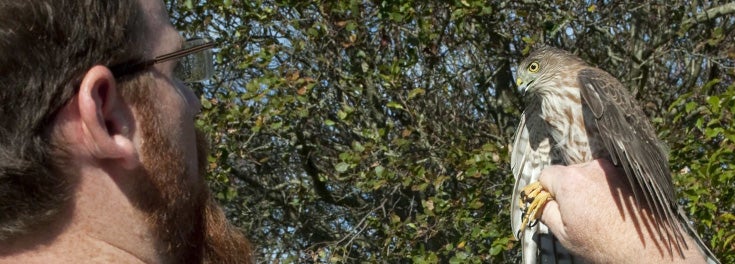
Autumn is a busy time of year in the natural world, which means it’s a busy time for students and faculty who study the natural world, as well. And one of the best things about studying the natural world at URI is that walls do not bind your classroom. Sure, we’ve got an amazing Center for Biotechnology and Life Sciences building with incredible labs and equipment, but we also have oceans and estuaries, forests and farms, and all manner of “field” classrooms as well.
For example, during fall bird migration, your classroom might just be the Kingston Wildlife Research station, or nearby Block Island, where you’ll get the chance to collaborate with scientists from the Department of Natural Resources Science. As millions of songbirds travel through the region, students and researchers work together to trap, band, and release birds for study. Or you might study temporarily captive birds in our custom-designed avian flight arena in Morrill Hall. By assessing food availability for birds at stopover sites and bird metabolism in the flight arena, students in Professor Scott McWilliams classes are gaining a better understanding of the energy requirements of migration and the physiological changes that birds undergo to prepare for their trip.
Sure, we’ve got an amazing Center for Biotechnology and Life Sciences building with incredible labs and equipment, but we also have oceans and estuaries, forests and farms, and all manner of “field” classrooms as well.
Birds aren’t the only flying creatures that migrate at this time of year, though. Bats do, too, and we’ve got the perfect place for studying them as well. From our rural W. Alton Jones campus to caves and mines in Vermont, New Hampshire and New York, Professor Peter August has been monitoring the population of little brown bats for 30 years. The long-term data he’s collected is proving useful in understanding the local effects of a disease that is wiping out bats throughout the East.
If the ocean is your thing, you might be interested in helping a whole interdisciplinary team of researchers and environmental organizations determine the best locations for Rhode Island’s first offshore wind farm. They’re using satellite transmission to study the migration patterns of sea ducks, to ensure the wind farms are as good for marine life as it is for us.
If you prefer plants to animals, our forests of spectacular rainbow fall foliage offer a great laboratory for botany and horticulture. Biological Sciences Professor Keith Killingbeck, who studies the ecology and physiology of plant nutrition dynamics, calls it the hunt for red October. “When plants can no longer photosynthesize efficiently, due to cold temperatures and their inability to take up water any more, they jettison their leaves,” he said. “But before they do, they break down the photosynthetic compounds in the leaves and extract some of the nutrients from them that they have a hard time getting anywhere else. When the chlorophyll molecules are broken down and disappear, it unmasks other colors.”
And in between studies of these autumn phenomena, you can join the URI Master Gardeners as they harvest campus and community gardens to donate fresh produce to local food pantries. Last year the Master Gardeners picked more than 7,000 pounds of produce, including apples, lettuce, green beans, squash and tomatoes, for the needy. It’s the perfect way usher in another change of seasons.
Related Links:
